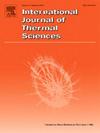Development of machine learning coupled one-dimensional simulation method for propane condensing flow and heat transfer in mini-channel
IF 4.9
2区 工程技术
Q1 ENGINEERING, MECHANICAL
International Journal of Thermal Sciences
Pub Date : 2025-06-17
DOI:10.1016/j.ijthermalsci.2025.110079
引用次数: 0
Abstract
LNG vaporizer with propane as the intermediate medium has unique advantages, of which the PCHE is the core heat transfer equipment. In this study, a one-dimensional simulation method was established, to achieve rapid and accurate calculation of propane condensing flow in mini-channel of PCHE. Firstly, the CFD study of propane condensing was conducted. The evolution of local h and p in the channel was analyzed by micro segment method, and a database was established with multiple parameters. Then, the highest precision artificial neural network hyperparameter model was determined through comparative analysis of six machine learning algorithms. The optimal machine learning model achieved the highest R2 values of 0.9887, 0.9947, and 0.9617, with the lowest root mean square error and mean absolute error. Finally, a one-dimensional simulation method is established based on the optimal machine learning model and an innovatively established vapor-liquid phase velocity ratio model. Comparing with computational fluid dynamics numerical simulation, the one-dimensional simulation only has an error of 2 %, while can improve the computational efficiency by tens of thousands of times. The new method of this research can provide a basis for the fast calculation of PCHE in LNG evaporator, and provide a new direction for the study of condensing flow in mini-channel.
微型通道丙烷冷凝流动与传热的机器学习耦合一维模拟方法研究
以丙烷为中间介质的LNG汽化器具有独特的优势,其中PCHE是其核心传热设备。本研究建立了一种一维模拟方法,以实现PCHE微通道丙烷冷凝流量的快速准确计算。首先,对丙烷冷凝过程进行了CFD研究。采用微段法分析了通道内局部h和Δ p的演化,并建立了多参数数据库。然后,通过对六种机器学习算法的对比分析,确定了精度最高的人工神经网络超参数模型。最优机器学习模型的R2值最高,分别为0.9887、0.9947和0.9617,均方根误差和平均绝对误差最低。最后,建立了基于最优机器学习模型和创新建立的气液相速度比模型的一维仿真方法。与计算流体力学数值模拟相比,一维模拟误差仅为2%,而计算效率可提高数万倍。本研究的新方法可为LNG蒸发器PCHE的快速计算提供依据,并为小通道冷凝流动的研究提供新的方向。
本文章由计算机程序翻译,如有差异,请以英文原文为准。
求助全文
约1分钟内获得全文
求助全文
来源期刊

International Journal of Thermal Sciences
工程技术-工程:机械
CiteScore
8.10
自引率
11.10%
发文量
531
审稿时长
55 days
期刊介绍:
The International Journal of Thermal Sciences is a journal devoted to the publication of fundamental studies on the physics of transfer processes in general, with an emphasis on thermal aspects and also applied research on various processes, energy systems and the environment. Articles are published in English and French, and are subject to peer review.
The fundamental subjects considered within the scope of the journal are:
* Heat and relevant mass transfer at all scales (nano, micro and macro) and in all types of material (heterogeneous, composites, biological,...) and fluid flow
* Forced, natural or mixed convection in reactive or non-reactive media
* Single or multi–phase fluid flow with or without phase change
* Near–and far–field radiative heat transfer
* Combined modes of heat transfer in complex systems (for example, plasmas, biological, geological,...)
* Multiscale modelling
The applied research topics include:
* Heat exchangers, heat pipes, cooling processes
* Transport phenomena taking place in industrial processes (chemical, food and agricultural, metallurgical, space and aeronautical, automobile industries)
* Nano–and micro–technology for energy, space, biosystems and devices
* Heat transport analysis in advanced systems
* Impact of energy–related processes on environment, and emerging energy systems
The study of thermophysical properties of materials and fluids, thermal measurement techniques, inverse methods, and the developments of experimental methods are within the scope of the International Journal of Thermal Sciences which also covers the modelling, and numerical methods applied to thermal transfer.
 求助内容:
求助内容: 应助结果提醒方式:
应助结果提醒方式:


